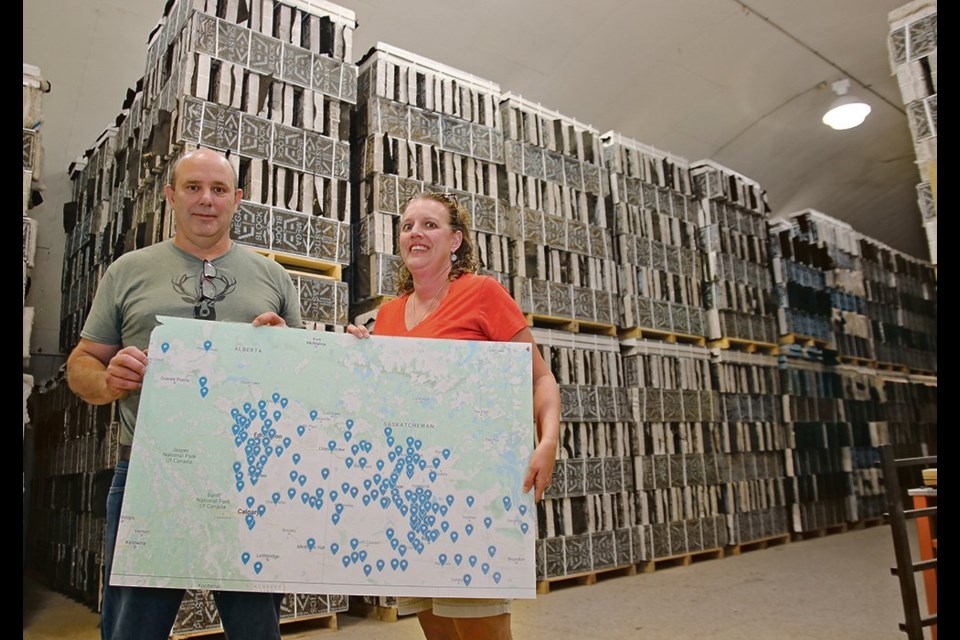The common seed market for alfalfa collapsed due to overproduction with prices plunging to 40 cents per pound compared to $2.20 a year earlier.
The couple from Imperial, Sask., made the gut-wrenching decision to warehouse that year’s crop and start their own marketing firm, Grower Direct Alfalfa Seed.
“It was either hold onto it and realize value out of it eventually or else sell it at a massive loss,” said Jed, who was raised on a sheep farm in Western Australia.
“It was either wait it out or just go broke.”
So while other alfalfa seed farms were either contracting or shutting down, they kept the same amount of acres and bees and stored their seed until prices rebounded.
They were eventually able to sell their seed in the 2018-19 crop year for $2.50 per lb. They continue to have one season’s worth of crop in the warehouse at all times.
“It gives us continuity of supply but at the very start, it was a real hard pill to swallow because we had no income,” he said.
It was a similar scenario for the leafcutter bee business, which is mostly run by Kathy, who grew up on a mixed farm near Imperial.
Bees that were wholesaling for $130 per kilogram in 2016 were suddenly worth $20 per kg by the end of 2017 as growers exited the alfalfa seed business.
The value of their bees plummeted to about $200,000, down from $1.3 million in 2016.
Once again they were forced to find a creative solution and formed Backyard Pollinator, a company where they sell small nesting blocks containing live larvae online and through Peavey Mart.
Each block contains about 200 larvae and they are sold to people who want to encourage pollination of their yards and gardens.
Kathy said she can sell a little bag of bees to the backyard enthusiast for as much as they wholesale a gallon of bees to other alfalfa farmers.
Most of the wholesale bees are sold to alfalfa growers in the United States, who have trouble keeping their bees year-round and need to replenish their supplies.
The couple owns 500 huts, or one for every four acres of alfalfa. It takes 20,000 to 30,000 bees to pollinate an acre of the crop.
Inside each hut are 18 to 24 nesting blocks. There are about 60 million larvae in all the nesting blocks combined.
In a good summer, they can double their bees, selling the excess to the wholesale and backyard markets.
Jed said things are going well now that they have a few years of direct marketing under their belt and the alfalfa and leafcutter bee sectors have recovered.
“The new frontier in agriculture is marketing,” he said.
“You can double your income by doing good marketing. You’re not going to double your income by doubling the size of your farm.”
They are pretty much maxed out for a family operation, growing between 1,500 and 2,000 acres of alfalfa a year.
The average yield is about 200 lb. per acre, so on a good year they will produce 400,000 lb. of seed and sell it for $2.50 per lb. to generate $1 million of revenue.
Half of that revenue goes to a farmer from Kenaston, Sask., who is their share-cropping partner.
The couple also grows their own alfalfa as well as grain, canola and lentils on about 1,200 acres that they own and rent.
There are constraints to growing the business any further, such as running out of warehouse space for the seed and bees. But they intend to continue adding value to the business.
For instance, they are considering building a seed cleaning plant so they don’t have to pay a third party to have it done.
Kathy said there is a strong motivation for further investing in the business.
“We’re trying to build something to give our kids the option of joining us if they wish,” she said.
The farming operation on its own isn’t enough to provide a good living for them and for their children when they become adults. They need the value-added businesses to make it viable.
The couple have three children, aged 10 to 15, who play an active role in many aspects of the farm.
Kathy enlists their help in the bee business during the busy period, which is the first half of the calendar year. They help with putting out and retrieving the nesting blocks, extracting bees and shifting huts.
They’re also involved in the shipping of the small backyard nesting blocks. The couple owns the local post office and is able to use Canada Post to economically deliver the blocks of larvae.
Jed said March through June is “nuts” on the seed side of the business because they are delivering product during that time. He can’t even take 90 minutes during an evening to watch a movie with his kids.
But he knows that if he leaves the marketing to the big seed companies they will syphon off all the profit.
Their sales pitch to farmers is that the seed is less expensive than if they get it through one of the big companies, it is winter hardy and the guy who picks up the phone when they call knows the product intimately.
“We really try to market as Jed the guy, Jed the farmer,” said Kathy.
“He’s the guy who grew it.”




